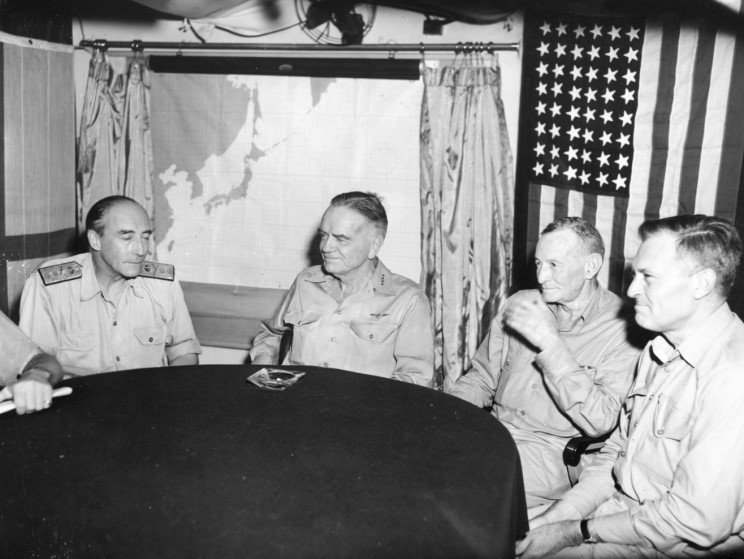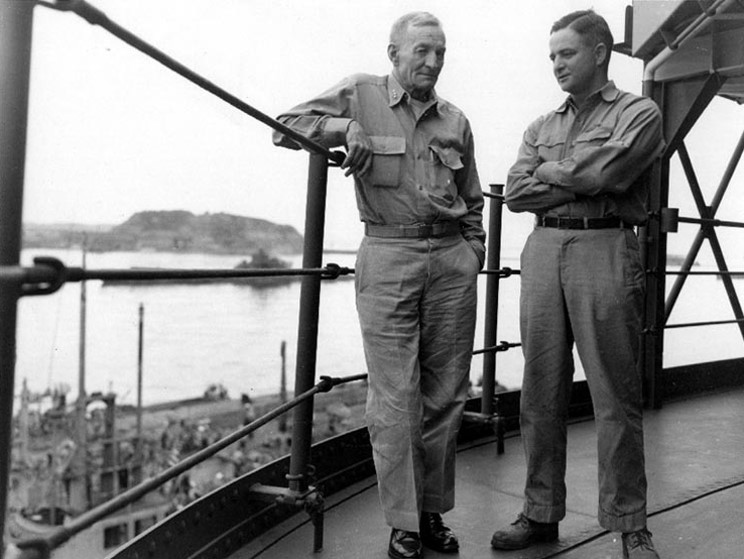Admiral John Sidney McCain Jr. USN |
|
(1911-1981) |
 |
September 1945: Admiral William F. Halsey Jr. (second from left) and Vice Admiral John S. McCain Jr. (third
|
 |
September 2, 1945: Vice Admiral John S. McCain Sr. and Commander John S. McCain Jr. seen in Tokyo Bay
|
John Sidney McCain, Jr. (January 17, 1911-March 22, 1981) was a four star admiral in the United States Navy. His father John S. McCain, Sr. was also a four star admiral in the Navy, and his son John S. McCain III is a US Senator representing Arizona and former Naval aviator Captain. Grandson John S. McCain IV is currently attending the United States Naval Academy. John S. McCain Sr. and Jr. are the only father-son group to have both achieved the rank of full Admiral.
Born in Council Bluffs, Iowa, he graduated from the United States Naval Academy in 1931. Like his father and son, he graduated towards the bottom of his Academy class. Both he and his son were consistently in trouble with the school's authorities. During World War II, "Junior" - who preferred to be called "Jack" - commanded the submarine Gunnel during the Torch landings. Like many U.S. subs in the Pacific, Gunnel was attacked in error by friendly aircraft. McCain had no end of trouble with the Hoover-Owens-Rentschler (H.O.R.) diesels (which were so troublesome, in the Pacific, Sub Force members called them "whores"); at one point en route, drive gears of all four of Gunnel's main engines went out of commission, and McCain had to rely on his tiny auxiliary for the last 1800km (1000nm). Gunnel went into the navy yard for extensive extensive refit, and was replaced on patrol station off North Africa by Pilly Lent's Haddo). In June 1943, McCain on his second patrol covered the East China and Yellow Seas. He was "fearlessly aggressive", sinking two ships (confirmed postwar by JANAC): Koyo Maru (6400 tons) and Tokiwa Maru (7000 tons). Yet the return of troubles from his H.O.R. diesels cut the patrol to only eleven days, after which he was compelled to return to Pearl Harbor. Yet Gunnel would be the first Pearl Harbor H.O.R. boat re-engined and returned to action, off Iwo Jima in December 1943). Alerted by Hypo of carriers, McCain lived a submariner's dream on the night of 2-3 December, getting a setup on Zuiho at a very long range of 5500m (6000yd, 3nm), only to have it ruined as Zuiho zigged toward. McCain fired four bow tubes, but scored no hits.[3]; he was still one of only a handful of U.S. skippers for the duration of the war to get such an opportunity. During his final patrol, on 18 March 1944 off Tawi Tawi, the main Japanese fleet anchorage in the Philippines, he got an amazing second shot at a carrier, firing from extremely long range (8200m {9000yd}); it came as no surprise when he missed and was counterattacked, facing a desultory sixteen depth charges. Then, after lying in wait four days, he had an astonishing third chance, on this same carrier; he got no closer than 10km (5.5nm). Amid the May 1944 U.S. air strike on Surabaya, Gunnel lay off Tawi Tawi, in company with Robert Olsen's Angler. McCain had no success, and moved to the coast of Indochina afterward, where on 8 June 1944, he picked up a convoy, escorted, incredibly, by yet another aircraft carrier. He proved unable to approach closer than his contact range, about 28km (15nm). On his return, he was detached to new construction. In five patrols, his contribution to the defeat of Japan had been slight. He was involved in the investigations that followed the USS Liberty incident. During the Vietnam War, Admiral McCain was serving as Commander-in-Chief of the U.S. Pacific Command when his son, Navy pilot (and future U.S. senator) John S. McCain III was held in Hanoi as a prisoner of war for nearly 5 1/2 years. He is buried in Arlington National Cemetery. |
(Text courtesy of www.arlingtoncemetery.net)
|
Page published Aug. 24, 2008 |